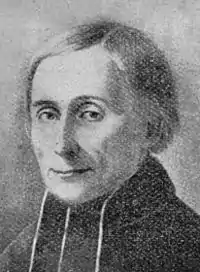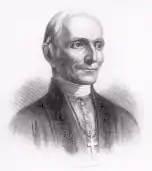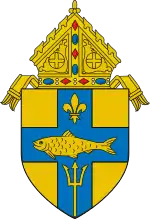Simon Bruté
Simon William Gabriel Bruté de Rémur (March 20, 1779 – June 26, 1839) was a French missionary in the United States and the first bishop of the Diocese of Vincennes, Indiana. President John Quincy Adams called Bruté "the most learned man of his day in America." [1][2]
Simon Bruté | |
|---|---|
| Bishop of Vincennes (now Indianapolis) | |
 Simon William Gabriel Brute from Who-When-What Book, 1900 | |
| Church | Roman Catholic Church |
| Archdiocese | Vincennes |
| See | Vincennes |
| Appointed | 6 May 1834 |
| Term ended | 26 June 1839 |
| Orders | |
| Ordination | 11 June 1808 |
| Consecration | 28 October 1834 by Benedict Joseph Flaget |
| Rank | Bishop |
| Personal details | |
| Birth name | Simon William Gabriel Bruté de Rémur |
| Born | March 20, 1779 Rennes, Ille-et-Vilaine, France |
| Died | June 26, 1839 (aged 60) Vincennes, Indiana, United States |
| Nationality | French |
| Denomination | Roman Catholic |
| Education | Seminary of Saint Sulpice in Paris |
| Sainthood | |
| Venerated in | Roman Catholic Church |
| Title as Saint | Servant of God |
Early life and education in France
Bruté was born on March 20, 1779, at Rennes, France. His father Simon-Guillaume-Gabriel Bruté de Remur served as Superintendent of the Royal Domains in Brittany, but died when the boy was only six years old. During the French Revolution, young Bruté helped his mother operate a print shop, learning to composite type and set pages. Despite his mother's efforts to shield him from the Reign of Terror and other horrors, the aristocratic youth still witnessed many disturbing scenes, including the trials and executions of priests and nobles. He frequented the prisons and made friends of the guards, who admitted him to the cells, where he received and delivered letters for the clergy incarcerated there. Disguised as a baker's assistant, Bruté would bring the Eucharist to imprisoned priests. The baker was, in reality, a priest in hiding.[3]
Bruté began studying medicine in 1796 and graduated in 1803, though he never practiced medicine. Instead, after graduation, he entered the reopened seminary of Saint Sulpice in Paris in November 1803. Ordained a priest in 1808, Bruté refused the post of assistant chaplain to Napoleon I, but instead joined the Society of Saint-Sulpice, and taught theology in the diocesan seminary at Rennes from 1808 through 1810.[3]
Due to his long interest in missions, Bruté met Benedict Joseph Flaget, who had left Saint Sulpice when it was closed during the French Revolution and then served as a missionary in the United States. Flaget had returned to the motherhouse after attempting to refuse appointment as bishop of the new diocese of Bardstown, Kentucky.
Missionary
In June 1810, Bruté sailed for Baltimore along with Flaget of Bardstown, Anthony Deydier, and others. He taught philosophy (while learning English) for two years at St. Mary's College, Baltimore. During vacations, he worked as a missionary. Bruté spent some time on the Eastern Shore. He was then sent to Mount St. Mary's College, in Emmitsburg, Maryland. In Emmitsburg, he acted both as teacher and as pastor, as well as spiritual director to Elizabeth Ann Seton. He became known for his unselfishness, his austerity, and his spirituality, as well as for his immense erudition. In 1815, he returned to France to retrieve his library, which he donated to St. Mary's College. Upon his return that same year, he was appointed President of St. Mary's College. Two years later, he returned to Emmitsburg, where at Mt. St. Mary College he lectured on Sacred Scripture and taught Theology and Moral Philosophy.[4] In 1826, Mt. St. Mary's College being no longer dependent upon the Fathers of Saint-Sulpice, its founders, Father Bruté ceased to belong to that society.
Bishop

French missionaries sent from Quebec had served Native Americans and fur traders throughout the region and particularly at Vincennes (founded 1732), including assisting George Rogers Clark during the American Revolution.[4] Afterwards, the area came under the jurisdiction of the diocese of Baltimore until the creation of the diocese of Bardstown. Missionaries such as Bruté and the more experienced Fr. Stephen Badin traveled by horse, foot, flatboat and canoe between widely scattered settlements. The neighboring Indians, called Bruté chief of the black robes and man of the true prayer.
American colonists had begun streaming over the Appalachian Mountains, joined by emigrants (including Catholic emigrants from France and Germany). Vincennes had been founded where the historic Buffalo Trace crossed the Wabash River and its subsidiary. Thousands emigrated from the East as well as South to settle central Indiana. This caused conflict with the Native Americans, who had lost the Northwest Indian War and the War of 1812. The sheer numbers of emigrants, many Catholic, helped qualify Indiana for admission as a separate state, with Vincennes as its first capital, although it soon moved north, ultimately to Indianapolis on the National Road. The state line at the Wabash River little affected missionaries such as Bruté and Badin. Bardstown, however, was across the falls of the Ohio River, and Kentucky, unlike Ohio, Indiana and Illinois, was a slave state, and slavery had become a major spiritual as well as economic issue in the new nation.
Rome split the diocese of Bardstown and created the Diocese of Vincennes, Indiana in 1834, the year after the Treaty of Tippecanoe caused many Potawatomi to relocate across the Mississippi River, although others remained, particularly the assimilated metis. In 1834, despite his protest of ill health, melancholy, and some difficulty to easily converse in English ("I lose the half of it and I am not understood"),[5] Bruté accepted the position of Bishop of Vincennes and crossed the Appalachian mountains to serve in the newly created diocese, which encompassed all of modern-day Indiana plus eastern Illinois.[3] He became the new diocese's first bishop and was consecrated in the same year at the Cathedral of St. Louis. On March 7, 1835 Bruté became a U.S. citizen, partly because of the requirements for land ownership.[6]
The entire diocese had but three priests, one of whom was on loan for a year from the Diocese of St. Louis. The new bishop soon traveled to France to recruit priests and seek funds, with which he built St. Francis Xavier Cathedral, a library, seminary and parochial schools. In addition to his episcopal duties and pastoral work, Bruté taught theology in his seminary and also in one of his academies. His correspondence with leaders of the church in America and with many in France was extensive. He maintained a correspondence with Hugues Felicité Robert de Lamennais, whom he tried to reconcile with the Church both by his letters from this country, as well as by conferring with him personally during one of his visits to France, but without success.[7] In 1836 Bruté returned from a trip to France with several clerical recruits, among them Benjamin Petit, who became a missionary to the Potawatomi. Bruté also drafted old acquaintances such as Anthony Deydier who arrived on the same boat as Bruté in 1810.
By the time Bruté died, the number of clergymen had grown. Bruté knew, however, that much work remained to be done. For a number of years before his death he had sought a coadjutor bishop, including Nicholas Petit S.J.[8] but the Superior of the Society of Jesus refused to allow Petit to be named. On May 17, 1839, Célestine Guynemer de la Hailandière was appointed Coadjutor Bishop of Vincennes.
Bruté knew the great assistance a religious order could provide, having worked with Mother Seton and her Sisters of Charity during the founding and early years of Mount Saint Mary's College in Emmitsburg.[9] Bruté sent Hailandière as a representative to their native France in search of a religious congregation to come to the diocese and teach, provide religious instruction, and assist the sick. The Sisters of Providence of Ruillé-sur-Loir sent Théodore Guérin and five others.
Death and legacy
Bruté died in Vincennes, Indiana, on June 26, 1839; he was buried under the sanctuary of the cathedral.[4] His great influence on the entire church, his success in planning, financing, and carrying out necessary ecclesiastical reforms, and the constructive and executive ability he displayed in his diocese, made him one of the foremost Catholic emigrants to the United States. He wrote Brief Notes on his experiences in France in 1793, in which he described state persecution of Catholic priests.
The name of the Latin School of Indianapolis, now closed, was changed to Bishop Bruté Latin School in his honor. The Archdiocese of Indianapolis runs a College Seminary named after Bruté;[10] students attend classes at the nearby Marian University.
In 2005, one of Bruté's successors, Daniel M. Buechlein (of the Archdiocese of Indianapolis – transferred from Vincennes in 1898), began the process for the eventual canonization of Bruté, who is now known as "Servant of God".[11]
Buechlein's successor, Joseph William Tobin, who was installed in December 2012, has continued Bruté's cause. Thousands of documents must be gone through before the 'cause' can be presented to Rome. Tobin quoted from Bruté's first pastoral letter in his own installation homily by saying " unworthy as I am of so great an honor, and of myself unequal of the charge, my only trust is in God; and, therefore, earnestly calling for your prayers, that I may obtain His Divine assistance, I come to be your chief pastor." [12]
References
- History of Old Vincennes and Knox County, Indiana, Volume 1 p. 412 By George E. Greene
- The Old Vincennes Cathedral and Its Environs p. 12 by Curtis Grover Shake
- Buechlein, OSB, Daniel. "Reflections on the life and times of Simon Guillaume Gabriel Bruté de Rémur: Pioneer Scholar – Bishop of Vincennes”
- Clarke, Richard Henry. "Right Rev. Simo Gabriel Bruté D.D.", The Lives of the Deceased Bishops of the Catholic Church in the United States, P. O'Shea, 1872, pp. 7 et seq.
 This article incorporates text from this source, which is in the public domain.
This article incorporates text from this source, which is in the public domain. - Coleman, Christopher B., Review of Sister Mary Salesia Godecker's "Simon Brute' de Re'mur, First Bishop of Vincennes", Indiana Magazine of History, Volume 27, Issue 2, pp 170-173, 1931
- Albert Henri Ledoux, "The Life and Thought of Simon Brute: Seminary Professor and Frontier Bishop" (Ph.D. diss., Catholic University of America, 2005), p. 392
- Dinneen, Michael. "Simon William Gabriel Bruté de Rémur." The Catholic Encyclopedia Vol. 3. New York: Robert Appleton Company, 1908. 31 January 2018
- C. M. Widman, 'Father Nicholas Petit, S.J., and the Coadjutorship of Vincennes, ' Woodstock Letters, XXXI (1902), 43.
- Brown, Mary Borromeo (1949). History of the Sisters of Providence of Saint Mary-of-the-Woods, Volume I. Saint Mary-of-the-Woods, Indiana: Benziger Brothers Inc.
- "Bishop Simon Brute College Seminary". Archindy.org. Retrieved 26 November 2017.
- "Servant of God Simon Bruté". Archindy.org. Retrieved 26 November 2017.
- "Installation Mass Homily". Archindy.org. Retrieved 26 November 2017.
![]() This article incorporates text from a publication now in the public domain: Herbermann, Charles, ed. (1913). "Simon William Gabriel Bruté de Rémur". Catholic Encyclopedia. New York: Robert Appleton Company.
This article incorporates text from a publication now in the public domain: Herbermann, Charles, ed. (1913). "Simon William Gabriel Bruté de Rémur". Catholic Encyclopedia. New York: Robert Appleton Company.
Sources
| Wikisource has the text of the 1911 Encyclopædia Britannica article Bruté, Simon William Gabriel. |
- Simon Bruté profile, indianacatholic.mwweb.org
External links
- Roman Catholic Diocese of Lafayette, Indiana Official website
